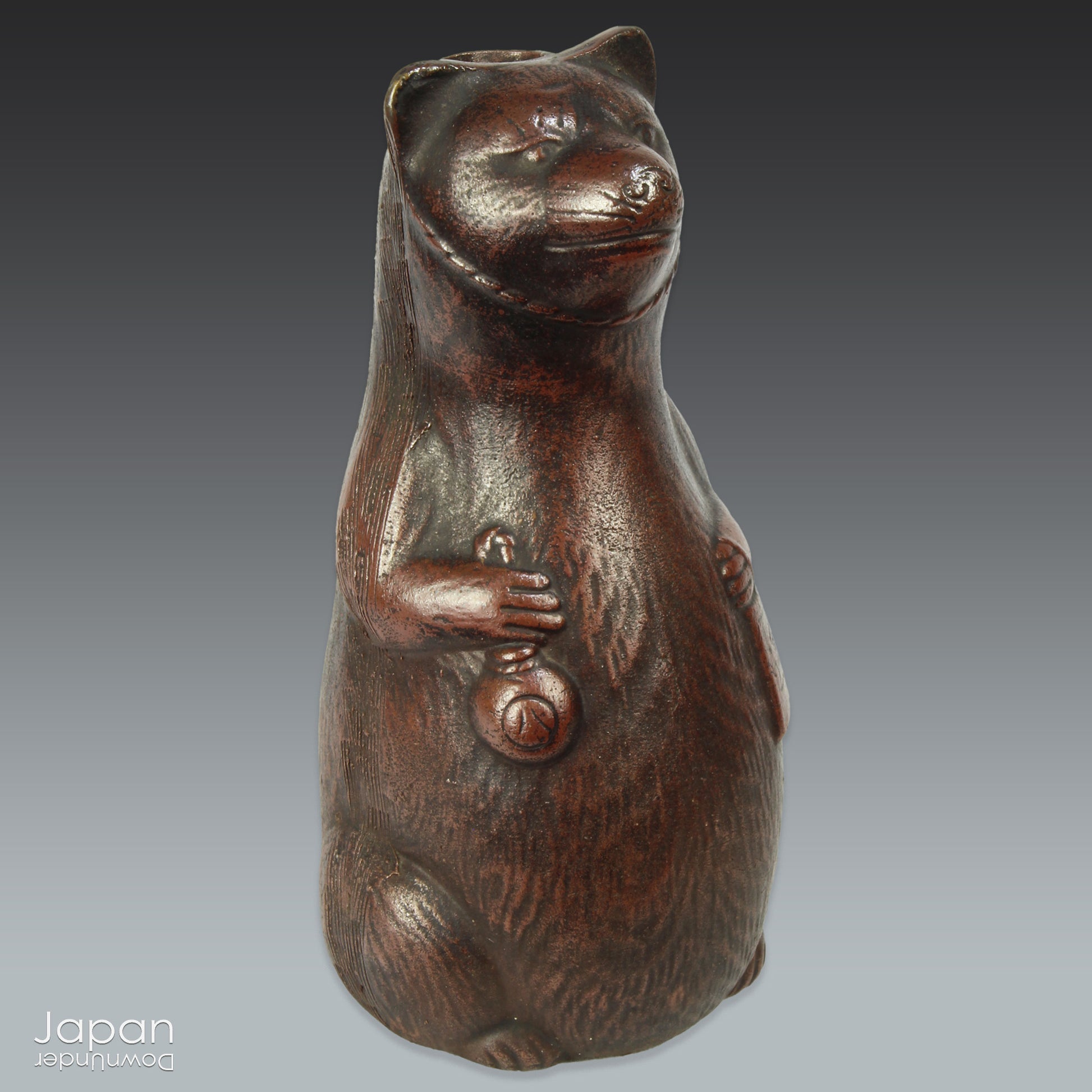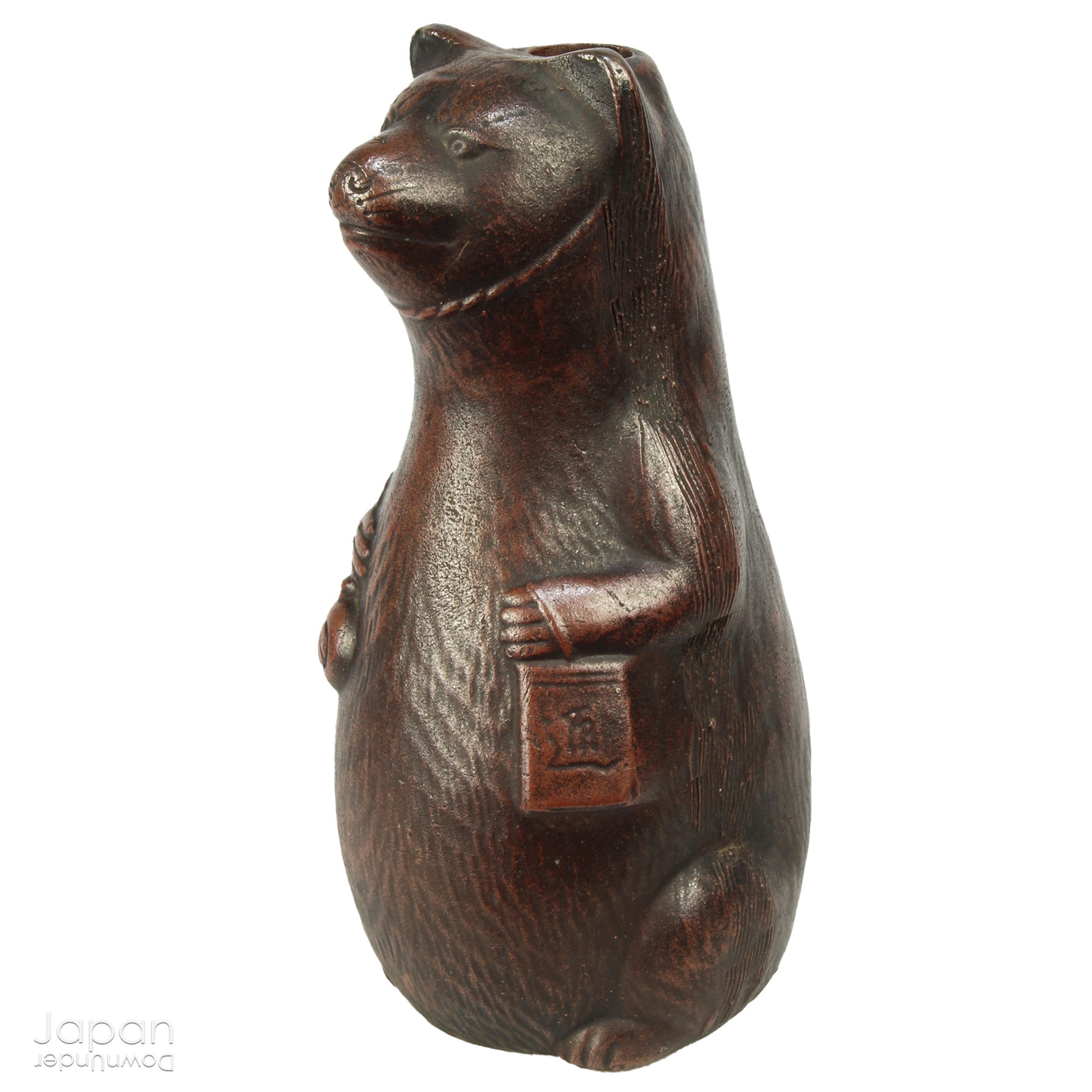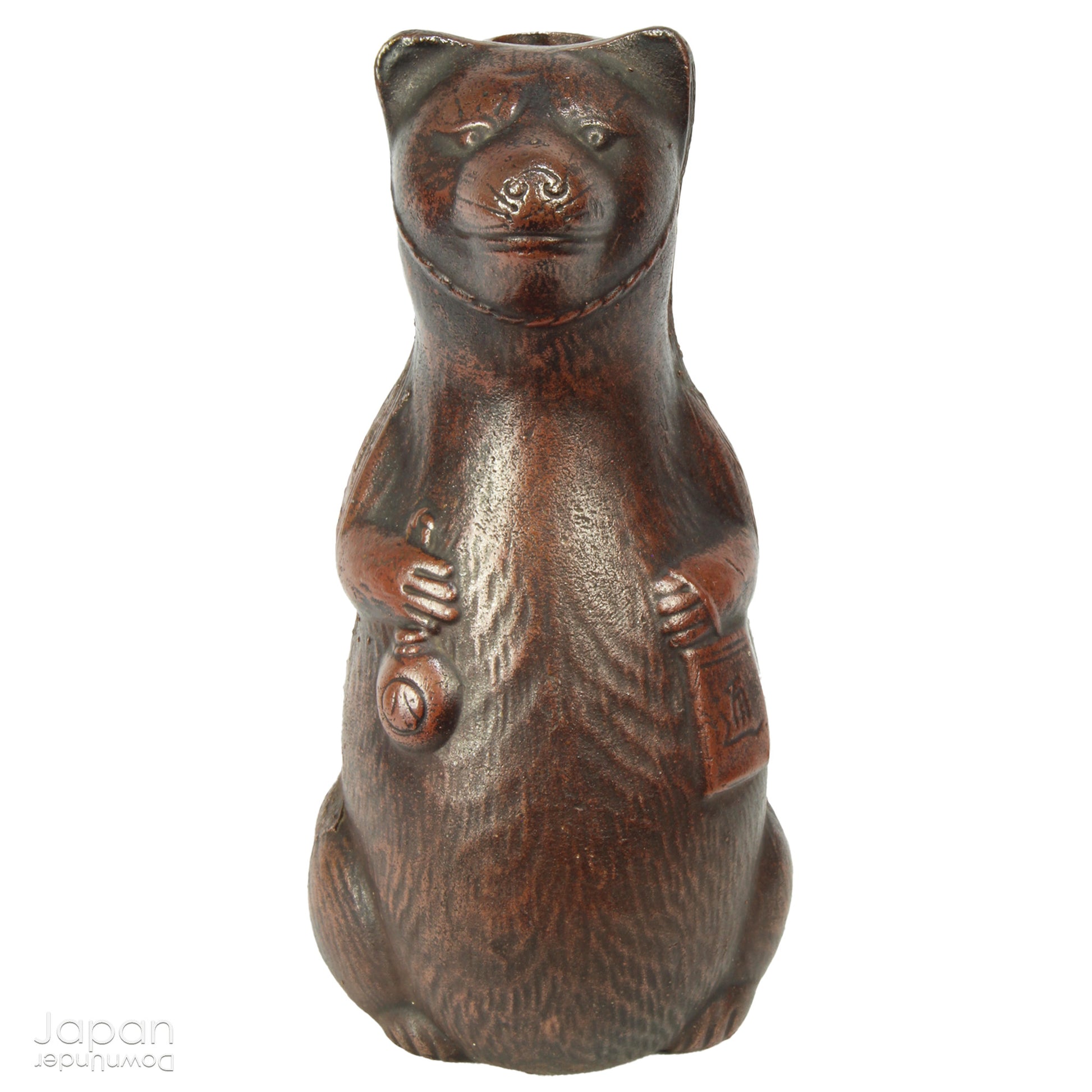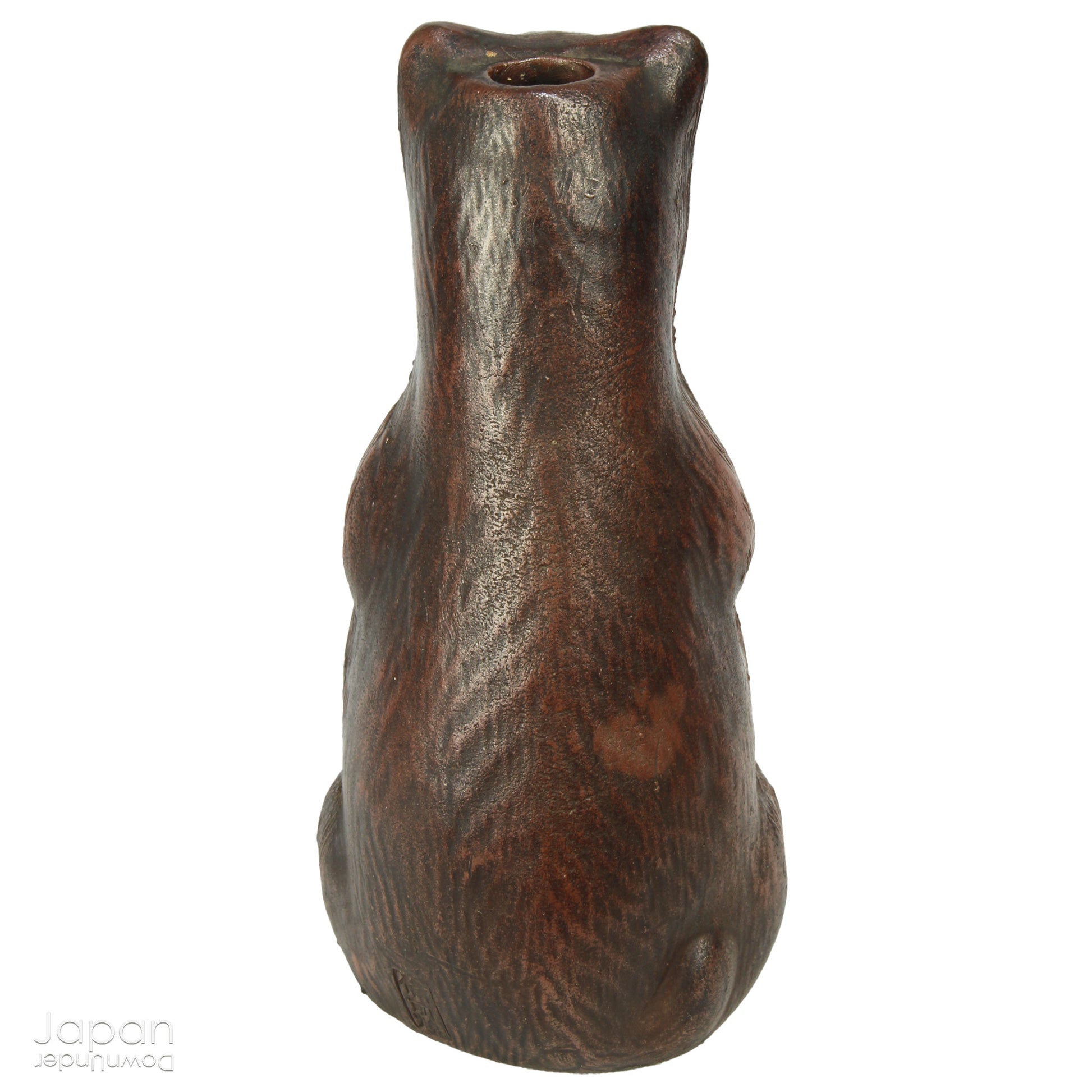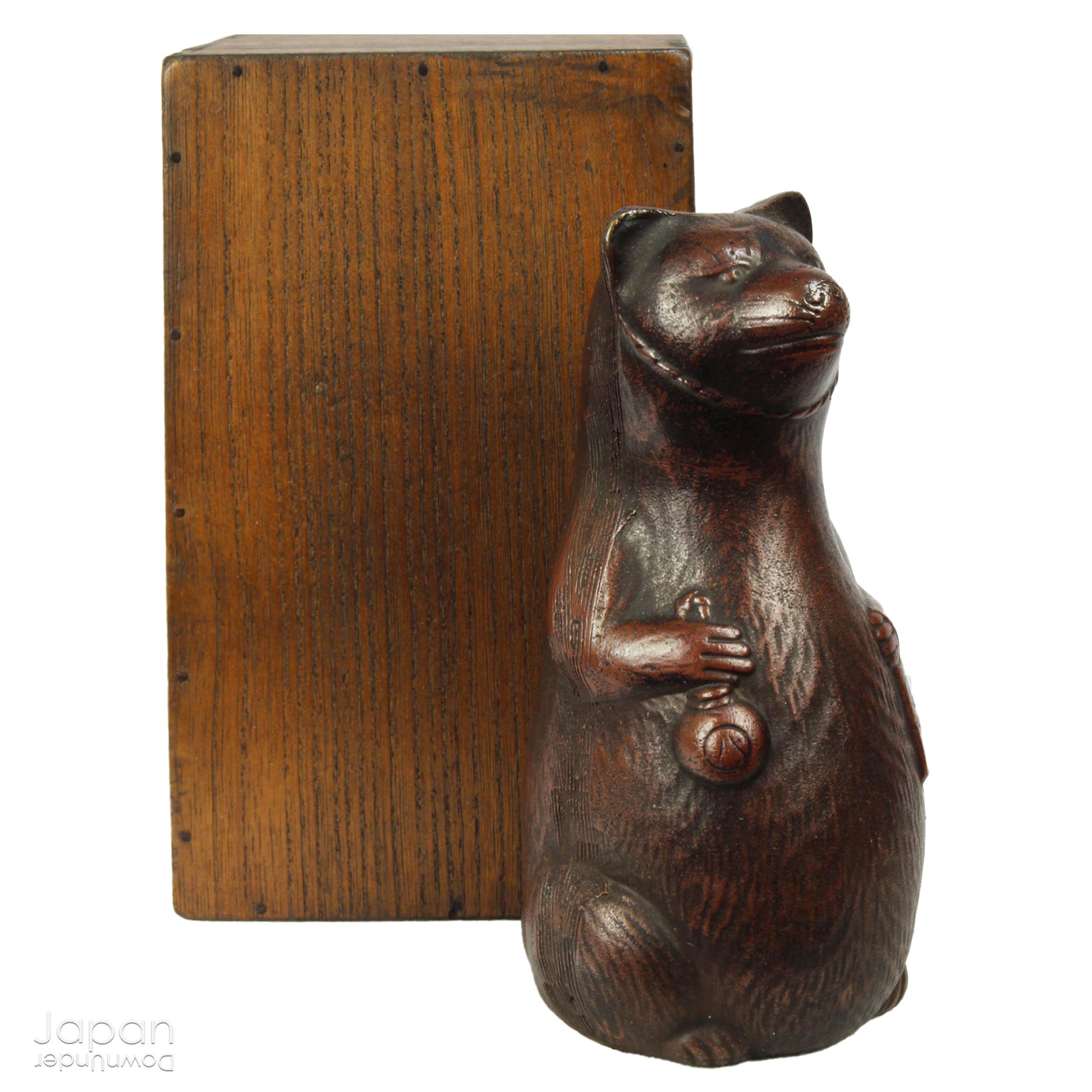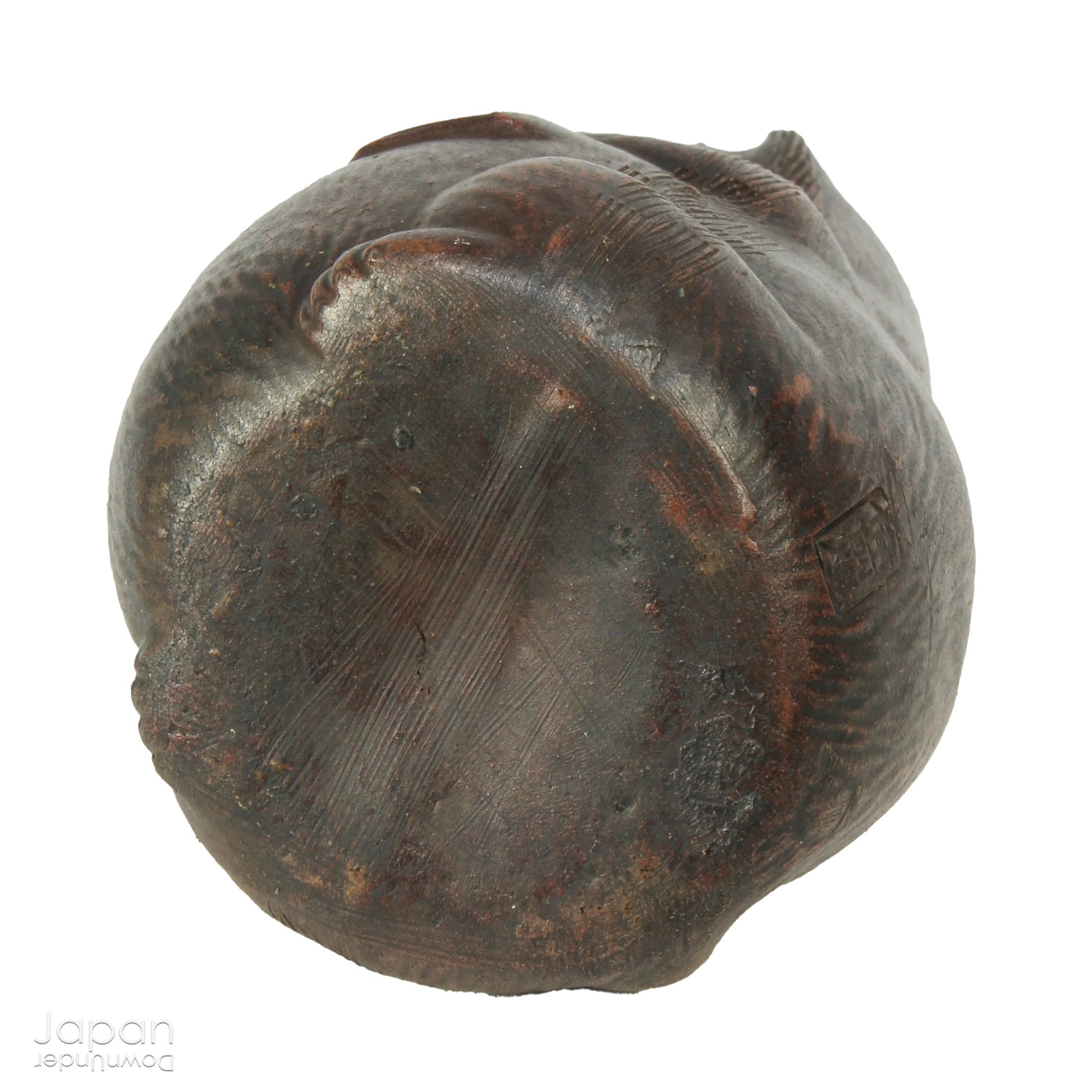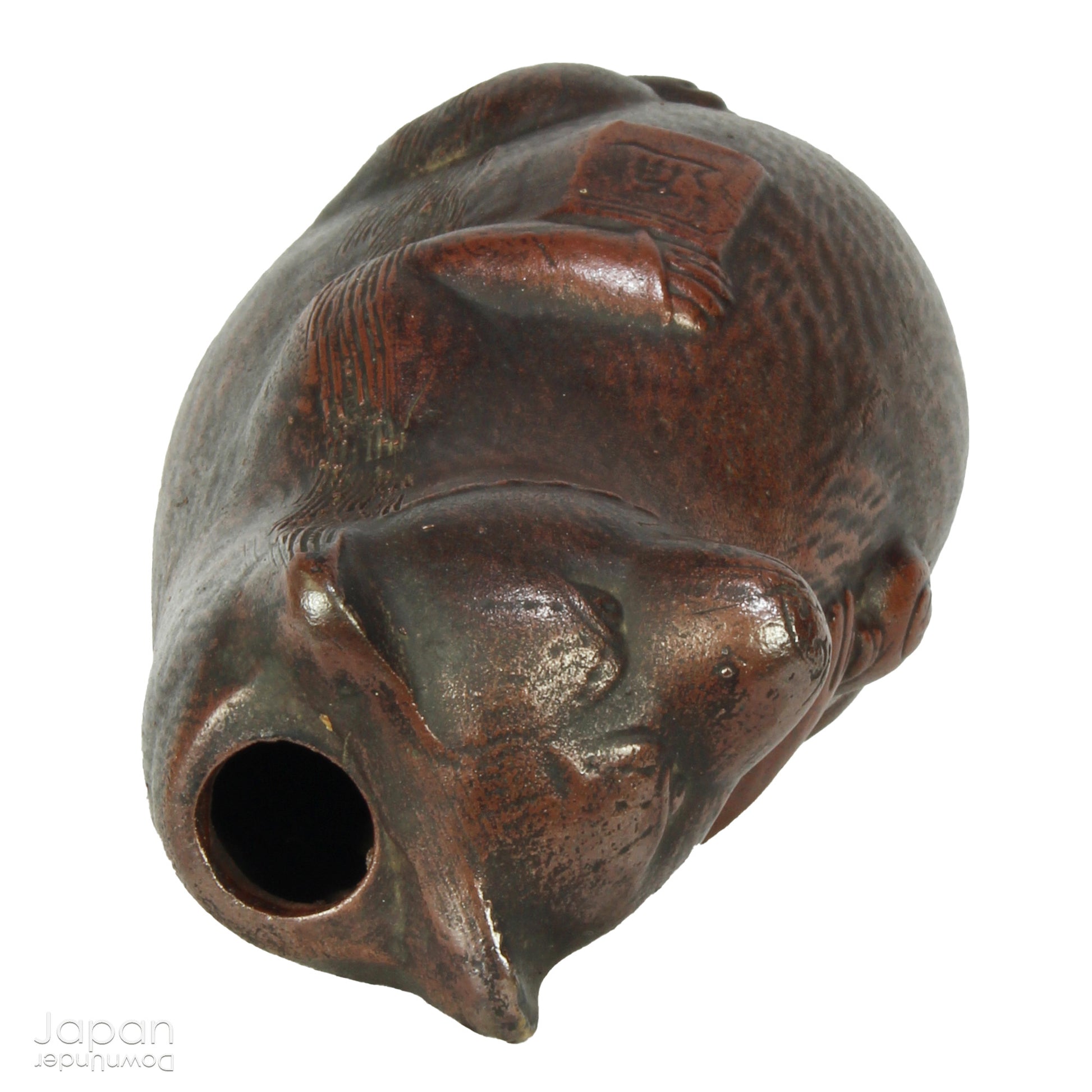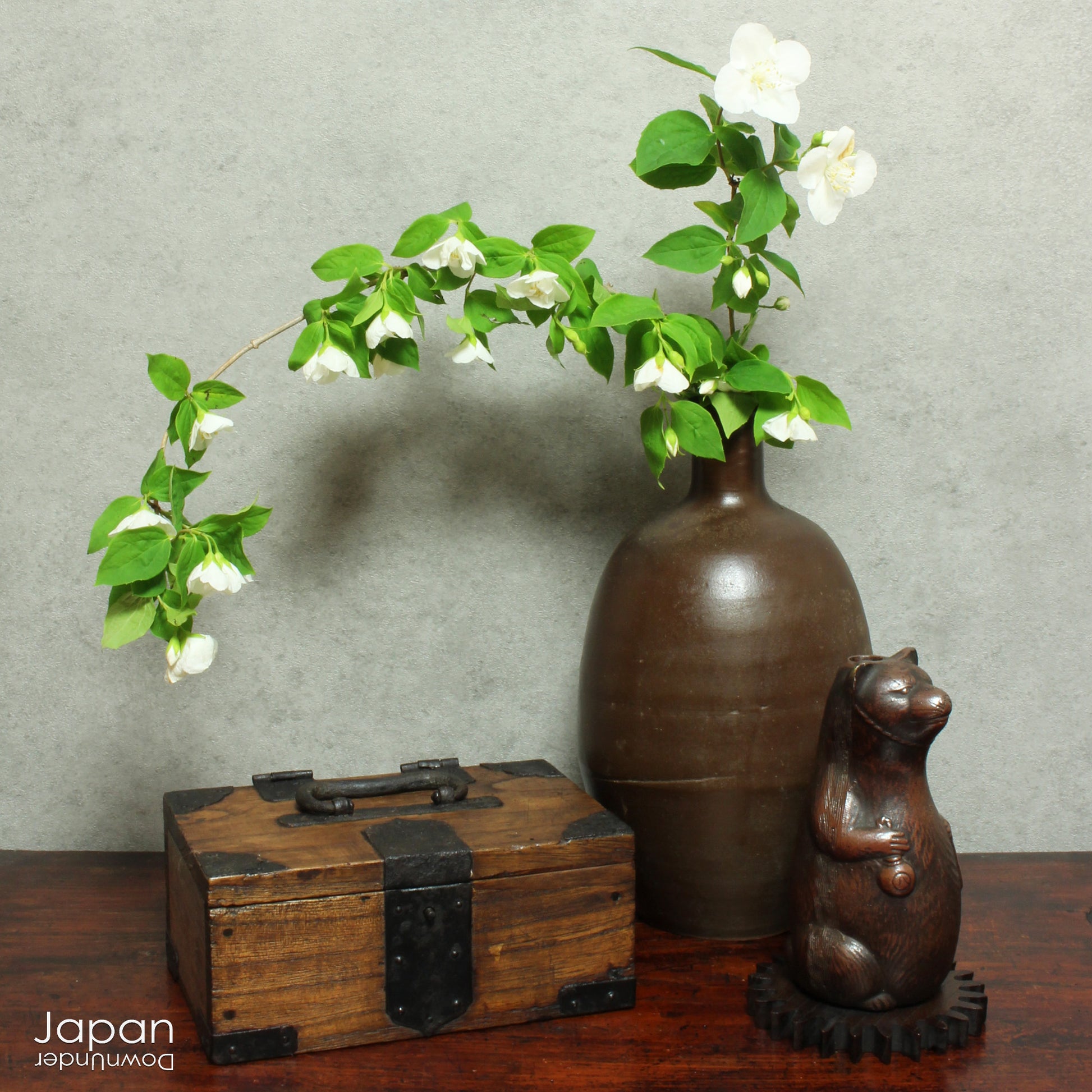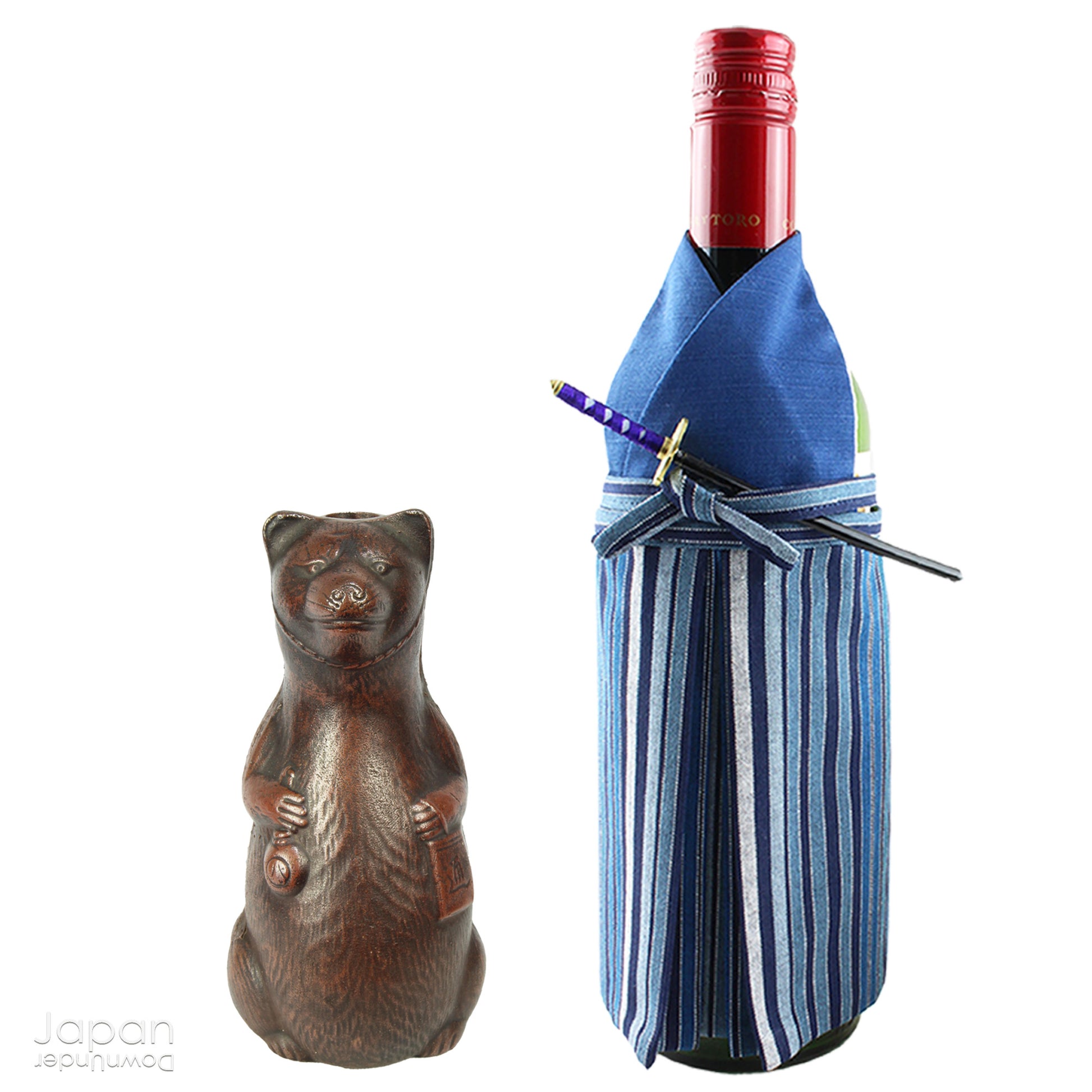JapanDownUnder
antique japanese bizen tanuki sake decanter - art object or bud vase
antique japanese bizen tanuki sake decanter - art object or bud vase
Couldn't load pickup availability
Love Japanese Style Like We Do
Infuse your space with the timeless elegance of Japanese craftsmanship and folklore through this antique Bizen raccoon dog tokkuri. Not only does it serve its traditional function as a sake pourer, but it also doubles as a captivating piece of art or a charming bud vase, making it a truly versatile addition to your collection.
This piece is a true example of the classic Bizen style - famous for its unglazed, earthy beauty - and dates back to the Meiji era (early 1900s). Bizen ware, produced in one of Japan's six ancient kilns, has long been celebrated for its organic aesthetic, rustic allure, and remarkable durability.
The raccoon dog, or tanuki, is a beloved figure in Japanese folklore, known for its mischievous shape-shifting abilities and good-natured spirit. Over time, the tanuki has become a symbol of good luck and prosperity, particularly in business. Holding a bottle of sake in one hand and an accounting notebook in the other, this delightful figure brings both whimsy and charm wherever it is placed. His big belly modestly conceals his private parts, adding a playful and endearing touch to the design.
The early tanuki tokkuri bottles are well crafted with intricate details etched into the clay, each with a unique facial expression. They are thinner than the later versions and the vessel has a rich reddish-brown hue, an iron-like hardness and a glossy sheen that only comes with age.
This particular tanuki tokkuri is in very good antique condition, with no chips or cracks, and it comes beautifully encased in a wooden box for safekeeping. The back of the bottle bears the signature Bizen seal, adding authenticity to its already rich history.
Whether you're using it to serve sake, displaying it as a unique ornament, or filling it with delicate blooms, this piece is sure to captivate. In Japan, it’s said that sake tastes better when poured from a Bizen vessel, and flowers last longer in a Bizen vase - proof of the enduring magic of this remarkable pottery.
- tanuki measures 15 cm (5.9”) tall x 7 cm (2.8”) across.
- weighs 500 gm.
(listing for boxed tanuki tokkuri only)
SHIPPING INFORMATION
- please read our shipping notes in shipping policy.
- we use recycle packaging wherever possible and wrap for safety, rather than appearance!
ABOUT OUR VINTAGE, ANTIQUE AND OTHER ITEMS
We list pieces we feel are worthy of display. There may be scratches, dents, fading and signs of wear and tear. We try to explain the condition of each item exactly, but may miss something.
Information regarding the item and it’s age is obtained from dealers and our personal research. We do our best to give you the correct information but please be aware that we cannot guarantee this information.
Please message us prior to purchase with any questions you may have about our products.
TANUKI
Tanuki folklore, originating from Chinese fox-lore, often depicts the animals as shape-shifters with supernatural powers and mischievous tendencies. In their earliest malevolent manifestations Tanuki assumed human form, haunted and possessed people, and were considered omens of misfortune. Many centuries later in Japan, they evolved into irrepressible tricksters, aiming their illusory magic and mystifying belly-drum music at unwary travelers, hunters, woodsmen, and monks. Today, the Tanuki are cheerful, lovable, and benevolent rogues who bring prosperity and business success.
Ceramic statues of Tanuki are found everywhere in modern Japan, especially outside bars and restaurants, where a chubby Tanuki beckons drinkers and diners to enter and spend generously.
The fun-loving Tanuki is commonly depicted with a big tummy, a straw hat, a bewildered facial expression (he is easily duped), a giant scrotum, a staff attached to a sake flask, and a promissory note (that he never pays).
Tanuki has eight special good luck symbols.
1. His big straw hat protects him from bad weather or bad luck falling from the sky, symbolizing preparation for unexpected trouble.
2. His big belly symbolizes level headedness and composure.
3. His tail symbolizes unflinching determination and perseverance.
4. His promissory notebook symbolizes honesty and gaining the trust of others.
5. His smiling face symbolizes kindness and a welcoming attitude.
6. His big round eyes symbolize discernment and making informed, good decisions.
7. His sake flask symbolizes thankfulness for ones’ daily food.
8. His giant scrotum, (kinbukuro, literally meaning gold bag), symbolizes good luck with money and the spreading of wealth.
Although the Japanese continue to classify Tanuki as a yōkai (monster or spirit), the creature today is no longer frightening or mysterious. Instead, it has shape-changed into a harmless and amusing fellow, one more interested in encouraging generosity and cheerfulness among winers and diners than in annoying humankind with its tricks.
BIZEN HISTORY
Bizen roots are the unglazed Sueki earthenware vessels of the Oku region. Sueki stoneware was made using techniques that came from Korea in the Kofun, (250 AD - 538 AD), Nara (71 AD - 784 AD) and Heian (794 AD - 1185) periods. It was fired in an anagama at high temperatures and was generally grayish brown in colour.
In the latter Heian period the sword industy flourished and as a result the scarcity of firewood intensified. Sueki potters moved to Imbe in search of wood for their kilns. Artistic Sueki ware was abandoned and pottery that was necessary for people’s daily lives was produced, giving birth to Bizen pottery. At this time Bizen ware consisted of mainly containers, mortar bowls and jars.
From the Kamakura period (1185 - 1333) into the Muromachi period,(1333 - 1573). Bizen pottery faced an age of unprecedented mass production and purchasing. The kilns that were once up in the mountains moved further down to the foot of the mountains. By the end of the Muromachi period the mountain clay used for Bizen pottery shifted to the use of clay from rice paddies.
Demand for Bizen ware increased and so did popularity, Goods had to be loaded and sent off from the harbour, so kilns gradually moved closer to Imbe village for convenient transportation. Bizen gained the reputation as a tough and sturdy ceramic with people saying, ‘even if you throw a Bizen earthenware mortar, it doesn’t break.’ Everyday wares were fired in large quantities and Bizen spread to various regions in Japan.
From the late Muromachi period into the Momoyama period, (1573-1603), masters of the tea ceremony, who had no utensils for their art, discovered aesthetic beauty in practical Bizen ware containers. By selecting Bizen ware, for use in the tea ceremony, as water jars and flower vases, Bizen household articles grew ever more popular.
From around the Genwa year of the Edo period (1615-24), Bizen Pottery began to show signs of its prolonged decline. Tea ceremony tastes moved towards the new, more elegant and refined porcelains of Arita, Seto and Kyoto ware. Bizen was seen as crude and ugly with its exposed reddish, earthy surface. Bizen potters focused on producing ornaments that replaced the popular tea-wares of before.
In order to compete against porcelain, the technique of ‘Inbe-de’ was developed, giving pieces a lustre like that of glazed ware or copper ware. White Bizen, celadon, and colored bizen, known as Shizutani ware were also made. Shizutani pottery did not succeed and demand for Bizen pottery declined to the extent that large communal kilns could not be fired.
From the Bunmei Kaika in Meiji (1868- 1912). the age of civilization and enlightenment, European ways flourished and the traditional culture of Japan was given lower regard. Crude, earthy, undecorated wares like Bizen were not in demand. With the development of transportation systems, glazed porcelain wares of Seto and Arita could be obtained at reasonable prices and this hastened the departure from Bizen wares. Although difficult to imagine the goods that were produced in the largest quantities by kilns in Imbe were earthenware pipes and bricks!
After World War 1, the Japanese economy reached a stage where it could stand equally alongside the nations of Europe and America.
The decline in the appreciation of Japanese traditional culture was reassessed with much enthusiasm. Tea ceremony became popular amongst the newly emerging wealthy class. Tea bowls, water jars and vases were in demand and the tea wares that this class craved were Seto, Mino, Iga, Karatsu and Bizen ware pieces from the Momoyama period.
For Bizen, there was one potter who paid attention to the tea wares of the Momoyama period. His name was Kaneshige Toyo (1896-1967).
Toyo, who had once been famous in figurative handiwork decided to focus on the ‘return to Momoyama’ in his mid 30’s and began to recreate famous wares of Momoyama Bizen. Thanks to Toyo’s existence, potters of the same generation were also greatly encouraged and from this, successive potters continued to thrive under his influence. As a result, potters pursue their art independently in Bizen and it is said that there are now approximately 400 potters producing Bizen wares around Imbe.
Share










